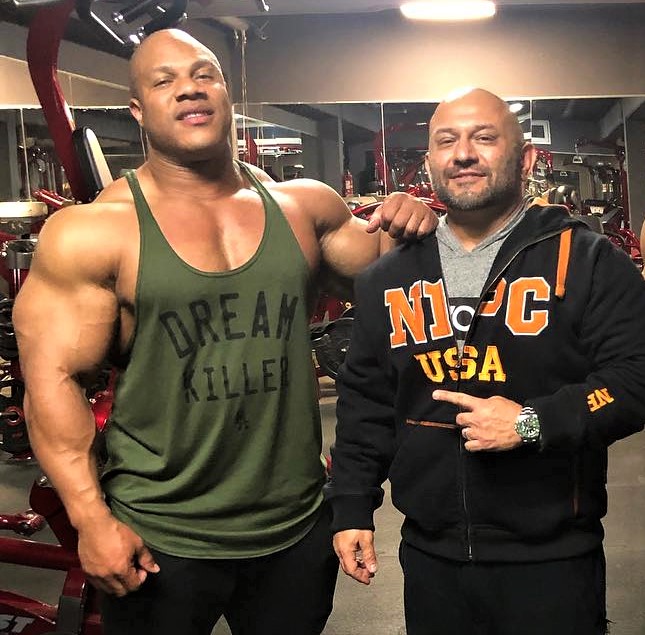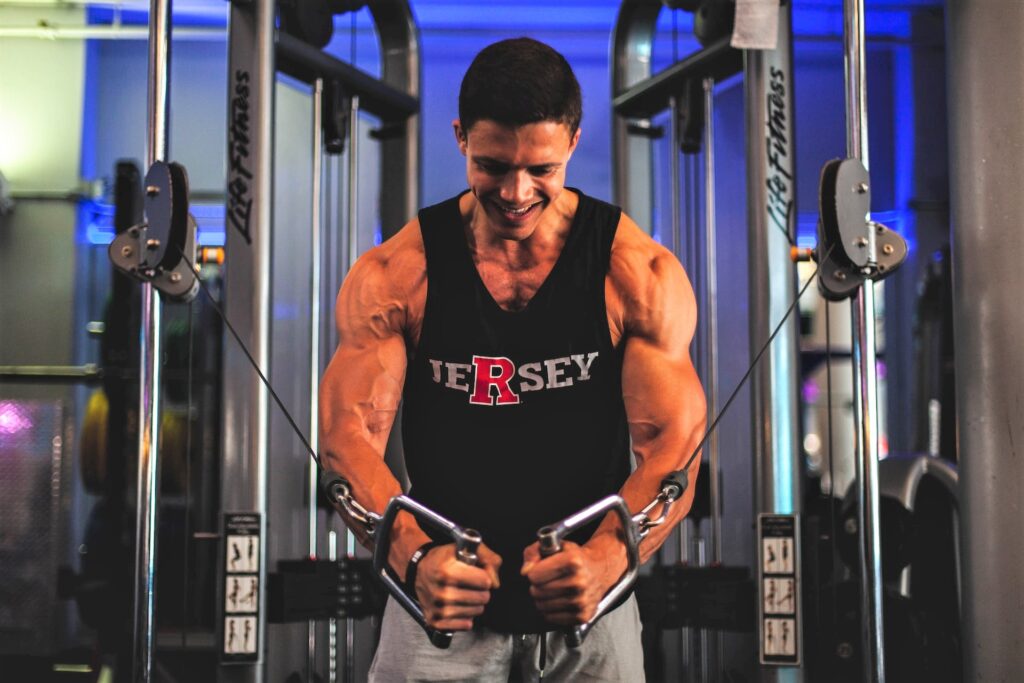Here’s some free advice for anyone thinking of creating a training system. Get a current or future Mr. Olympia to do it, and hope he likes it enough to keep doing it regularly for years. Systems come and go, but when the king of bodybuilding adopts a workout philosophy, it’s destined to stick. And so it was with FST-7. Trainer/nutritionist Hany Rambod developed Fascia Stretch Training Seven in 2007 primarily to boost the intensity of his No. 1 client, Phil Heath, who almost always trained alone. Heath went on to win seven consecutive Mr. Olympias (2011-17). Was FST-7 the main reason? No. But it did help intensify his workouts.
Let’s crack the FST-7 code and discover the benefits of sets with reduced rest.

WHAT IS FST-7?
If there’s a secret to FST-7 (fascia stretch training seven), it’s not what it does. It’s what it doesn’t do. It doesn’t deviate from the mid-range rep scheme. There are no especially low-rep or high-rep sets. Sets that reach failure at 8-12 reps are in the sweet spot for growth, so that’s what FST-7 prescribes. Furthermore, there’s no need to learn unique exercises or techniques or greatly deviate from typical workout volume. Stick to proven free-weight and machine basics, and do three or four straight sets of most exercises. Rest two to three minutes between sets.
Except for one exercise per body part…
Typically on the final exercise for each body part (which is also usually an isolation exercise), things are done differently. Rest periods are reduced to 30 seconds and volume is increased—usually to seven sets (hence the “7″ in the title). So, whereas before you were doing three sets with 4-6 minutes total rest (2 to 3 minutes between each set) or four sets with at 6-9 minutes total rest (2-3 minutes between each set), on the final exercise you do seven sets with only a total of 3:30 rest between (30 seconds between each set). Here’s the sevens formula: A lot more sets, a lot less rest.
That said, Hany Rambod ascribes nothing magical to the number seven. You can do other set multiples: fives, sixes, eights, etc. The key is the reduced rest. It enhances the pump and thus, in theory, expands the thin membranes around muscles from the inside out (hence the “FS”—fascia stretch—in the title). Color us skeptical that such pumps do much to permanently expand the fascia. (We have much more on how to properly do fascia stretching here.)
WHAT DOES FST-7 DO?
Let’s leave the concept of fascia stretching aside. We’re more certain sevens accomplish the following three things:
✹ First, sets with reduced rest infuse the targeted muscles with a final pump, and the enhanced blood flow better transports the nutrients necessary to begin the repair and growth processes.
✹ Second, these sets are not merely for a pump. They also stimulate growth. Use the same weight for all the sets and, if possible, stay in the 10-12 rep-range. Sevens should not be confused with drop sets or high-rep, lighter-weight barrages. Maintain the same weight until and unless you fall below 10 reps. Then, either reduce the weight slightly or increase the rest periods slightly, up to 45 seconds.
✹ Finally, sevens can serve as a rescue, a final defense against the dreaded bland workout, which is, frankly, the main reason Hany Rambod prescribed them for Phil Heath, who almost always trained alone. Even if your strength is down or energy is waning, you can ratchet it up for your sevens to make certain you end your routine on a vein-bulging high, just like a Mr. Olympia.

WHO SHOULD DO FST-7?
FST-7 isn’t for everyone. It’s an intermediate or advanced technique, but you certainly don’t need to be prepping for the Mr. Olympia to incorporate it into your workout. FST-7 is good for bodybuilders beyond the beginners’ stage, meaning those with at least one year of weight-training experience. And it’s especially useful for people who train alone and are looking to up their workout intensity. It can get you through growth plateaus, or it can rescue a workout that didn’t go as well as you wanted it to. They can also speed up your workout, if you’re running late. Because sevens are, typically, done on only the last last exercise of a body part routine, you can always insert them into a workout, even if you hadn’t planned to use FST-7 that day.
FST-7 BASICS
✹ Sevens are the key to FST-7. These are, typically, seven sets of one exercise with 30 seconds of rest between sets.
✹ Seven sets isn’t mandatory. Sevens could also be fives or sixes, etc.
✹ Most of your workout should focus on basic exercises for three to four sets each with rest periods of two to three minutes.
✹ It’s best to do sevens on the final exercise for a body part.
✹ FST-7 is a training style you can easily perform without a training partner.
FST-7 TRAINING TIPS
✹ Choose an isolation exercise for sevens, such as leg extensions for quads or cable crossovers for chest.
✹ On sevens, try to keep your reps in the 10-12 range and rests at 30 seconds. Only decrease the weight or increase the rest if you fail to get 10 strict reps.
✹ Carefully time your rest periods during sevens to avoid over-resting or under-resting. Don’t guess.
✹ Consume a nitric oxide-boosting drink (with citrulline and/or arginine) pre-workout, and stay hydrated during the workout.
FST-7 WORKOUT: CHEST
Incline Barbell Press — 3-4 sets x 8-12 reps (rest: 2-3 minutes between sets)
Incline Dumbbell Flye — 3-4 sets x 10-12 reps (rest: 2-3 minutes between sets)
Hammer Strength Chest Press — 3 sets x 10-12 reps (rest: 2-3 minutes between sets)
Cable Crossover — 7 sets x 10-12 reps (rest: 30 seconds between sets)
FST-7 FAQS
What is the FST-7 method?
FST-7 stands for fascia stretch training. Most sets are done as usual, but, typically, the final exercise for a body part is performed for seven sets with only 30 seconds rest between sets.
Is FST-7 good for muscle growth?
Yes. FST-7 sets are kept in 8-12 rep range with maximum weights. So FST-7 mixes moderate rep ranges, progressive resistance, and increased intensity (via reduced rest), all of which are good for muscle growth.
What is the rest period for FST-7?
Most sets are performed as usual with 2-3 minutes rest between sets. Sevens are performed with only 30 seconds rest between sets (a little longer if necessary to get 10 reps on your final sets with the same weight).
What is the rep range for FST-7?
Most sets are in the 8-12 rep range. Sevens are performed for 10-12 reps with 10 being the minimum you must hit.
How many sets are in FST-7?
Most exercises are performed for three or four sets. Sevens are performed for seven sets. That said, you don’t necessarily have to do sevens for your 30-second-rest sets. You could do sixes (six sets), eights (eight sets), for examples.
What are the benefits of FST-7 training?
They provide a final pump to the targeted muscles, bringing in nourishing blood. They may help you get through growth plateaus or rescue a bland workout. And they can shorten a workout by reducing rest periods in the final exercise.
Who does FST-7?
Many intermediate and advanced bodybuilders. It’s most associated with Phil Heath, who did FST-7 during much of his seven-year run as Mr. Olympia. Four-time Mr. Olympia Jay Cutler also did it for a period. 2022 Mr. Olympia Hadi Choopan and four-time Classic Physique Mr. Olympia Chris Bumstead have also done it.
How does FST-7 work?
It works by keeping all weights in the moderate range, using maximum weights in that range, and reducing rest periods on the final exercise(s), therefore increasing intensity and muscle blood volume.
Does FST-7 actually work?
It does, but don’t expect Olympia-sized gains. It’s just another way to increase your workout intensity, in this case, safely and while training alone.
















































